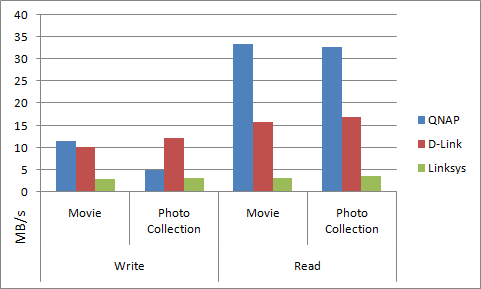Pardon me while I diverge into geekdom for a minute...
Since I wasn't totally satisfied with the performance of the 2 Network Attached Storage (NAS) units we had, I recently purchased a much more robust one. I wanted to run some tests to see how much better the new unit with my type of usage.
The NAS units
| NAS Unit | Disks | RAID Type |
| QNAP TS-419P | 4 x Western Digital Green 1TB | RAID-5 |
| D-Link DNS-323 | 2 x Western Digital 500GB | RAID-1 |
| Linksys NAS200 | 2 x Western Digital 500GB | RAID-1 |
The first thing you'll notice is that the 3 NAS units I have have slightly different configurations. Keep this in mind as you read the remainder of this article, these different configurations are sure to figure in the overall results.
Test Process
While the NAS configurations aren't totally consistent, I did use a consistent set of parameters to run my tests. I copied two sets of files to/from the NAS units using Microsoft's RichCopy utility:
- Movie - 1 file: 4.3GB
- Photo Collection - 8,900 files: 8.94GB
Test Results
The following chart summarizes the results of my tests.

Observations
The first time that stands out is that the QNAP enclosure is substantially faster than the other two with one exception. The QNAP lost out to the D-Link in the write test of the photo collection. The likely explanation for this is the fact that, in general, write operations on a RAID-5 have more overhead compared to simple mirroring as in RAID-1. In all other tests, in particular the read tests, the QNAP unit performs significantly better.
Another observation not captured by the raw data pertains to working with a smaller amount of files (as in, when editing 1-2 photos for example). Under these circumstances, the write operations appear to be nearly instantenous with the QNAP, something that I didn't really notice with the other two units. I'm guessing that the QNAP does a lot more caching than the D-Link and Linksys. Clearly, that cache isn't large enough to impact the write tests which used such a large amount of data.
All in all I have been very happy with the QNAP TS-419P. While it is a pricier unit compared to the other two, the added performance (in addition to the feature sets) made it a worthwhile purchase.